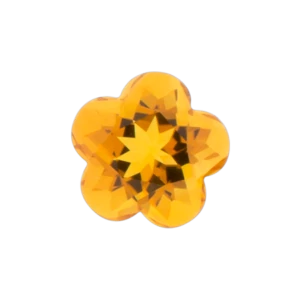Citrine
Citrine stone is a mineral belonging to the quartz family and is sometimes referred to as yellow hyaline quartz. Used for its benefits in lithotherapy as well as for its energizing virtues and encouraging creativity, the citrine stone is highly appreciated. Its characteristic yellow color earned it the name “citrus” originally for its similarities with lemon in terms of its color. Very aesthetic, citrine stone is used in jewelry: bracelets, pendants, earrings, necklaces, rings, citrine is highlighted on many jewelries.
Citrine: general data
Natural citrine, that is to say citrine that has not received any chemical treatment or has been heated, belongs to the quartz family. Citrine stones are composed of iron silicon dioxide and citrine is yellow in color thanks to this low presence of iron oxide.
The citrine stone has its origins in the Latin “citrus”, which means “lemon”, in reference to its yellow color. The hardness of the citrine stone is located at 7 on the Mohs scale, to emphasize that it is rather rare for natural minerals.
There are fake citrine stones where most of the time it is amethyst stones heated to more than 500°C. With the change in temperature, the purple color of the amethyst stone turns yellow.
Origins of citrine stone
Citrine is a stone known since ancient times and has always been popular and used. At the time of Ancient Greece, citrines were used as a lucky charm and thus fought against the evil eye.
Citrine pendants were highly sought after for their aesthetics and virtues.

How much does citrine cost?
The price of these minerals can vary according to certain criteria such as the weight, the purity of the citrine stone, the size and the deposit from which it comes. Citrines are usually found in tumbled or raw stone in specialist lithotherapy stores, but you can also find it in the form of jewelry at jewelers. Citrine is resplendent with its shades of yellow and its high quality.
This lemon-yellow crystal can set bracelets, rings, earrings or even necklaces.
As for its price, the average cost is around 20 CHF per 100 grams (500 carats).
The virtues of citrine stone
Natural citrine stone is known for its many benefits on the body and mind in lithotherapy. Citrine has the ability to raise one’s inner radiance while regulating ego and pride. It allows you to take a step back from the most complicated everyday situations. Citrine is known in lithotherapy to help break its shells by regulating fears and anxieties of all kinds.
In lithotherapy, citrine is recommended for people in conflict with authority, having the impression of disturbing, who do not recognize their value or even people afraid of commitment.
Using, cleaning, purifying and recharging citrine stone in lithotherapy
In lithotherapy, it is advisable to use citrine during periods of sadness, helplessness and if the person feels like they are deviating from their course. The citrine stone helps to find the resources and the strength necessary to move forward, to be motivated, happy and free-spirited again.
In lithotherapy, citrine is placed on the stomach in the evening before sleeping. It is then recommended to place it near the head during sleep in order to benefit from its energies and properties. It is advisable to sleep with a citrine over several days or even weeks. Citrine allows reconnection with one’s inner light, values and energies.
Cleaning and purification of citrine stone: how to recharge it?
The natural citrine stone is cleaned by simply soaking in water. After using citrine, it is essential to purify it by soaking it for a few hours in spring water or salt water. It is then important to recharge the citrine directly in sunlight for 2 to 3 hours. It is also possible to recharge citrines with an amethyst or quartz geode.
The rays of the sun are important for the recharging of citrine, this quartz is a solar stone and always associated with heat. It is a stone with positive and regenerative energies, citrine carries the heat, the strength of the sun. Citrine is the sunstone par excellence and thus helps to recharge the chakras thanks to its benefits.
The citrine stone is associated with the 3rd chakra which is also called the autumn / fall chakra or Manipura chakra or the solar plexus chakra. In order to take advantage of its virtues and benefits, it is possible to place a citrine daily in your pocket or near you or to wear it as jewelry, the most practical and safe alternative. The choice is vast: in bracelets, a pair of earrings, pendants or even necklaces and rings, the jewels are aesthetic and allow you to keep the citrine close to you.
However, we recommend avoiding any contact with a source of excessive heat in order to keep the shine of the citrine stone. It is also essential that the citrine is not exposed to intense light for a long period of time. Finally, it is recommended to remove your jewelry with citrine stones to avoid damaging them or exposing them to aggressive or chemical products. Citrines are quite fragile minerals, like all stones, it is important to take precautions, especially when wearing a bracelet or a ring since these jewels are more exposed to potential shocks. With its warm color, its energies and its virtues, citrine brings confidence and well-being.






